Israelis are headed to polling stations throughout the country Tuesday to elect the 25th Knesset. The nation’s fifth vote in under four years takes place as multiple opinion polls predict an incredibly tight race between parliament’s two blocs, with a distinct possibility of further stalemate and no bloc clinching the 61-lawmaker majority in the 120-seat parliament to form a government.
Frontrunners in the campaign to form a government are former prime minister Benjamin Netanyahu, with his Likud party and its right-religious allies, and current caretaker Prime Minister Yair Lapid, with his centrist Yesh Atid party and its diverse crew of supporting parties, united in large part by opposition to Netanyahu. Another hopeful is Defense Minister Benny Gantz, head of the National Unity party, who has campaigned as a compromise candidate who can reach across blocs to find the elusive majority.
Netanyahu’s bloc has polled strongest, in the high 50s and up to 61 seats in major network polls. Lapid’s bloc has never passed 56 seats in those polls, and he has been unable to articulate how he would form a government if the polls prove true. Rather, if those sometimes unreliable surveys are accurate, Lapid’s best hope may be in blocking Netanyahu or another candidate from mustering a viable coalition.
Gantz has tried to position himself as an alternative to both Netanyahu and Lapid, who inspire strong opposition from political rivals. However, the bloc-busting coalition constellation he proposes includes parties nursing bitter enmities, and it is unclear how he could hit the magic number himself.
That said, a number of factors hang in the balance that could shift the Knesset map predicted by pollsters and pundits. Even a small change might shake loose the stalemate and open a path to power for one of the contenders.
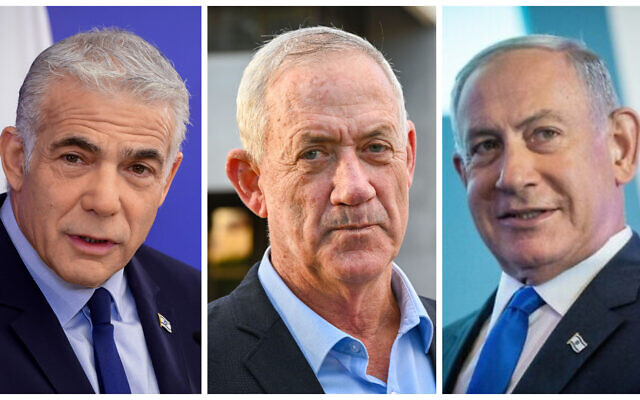
Prime Minister Yair Lapid (L), Defense Minister Benny Gantz (C) and Opposition Leader Benjamin Netanyahu (R) (Flash90)
1. Arab voter turnout
There are three Arab lists running in the current election, and their fate could seal the fate of the Lapid-led bloc. With Arab turnout expected to be lower than in previous rounds, the Arab vote could become a crucial matter.
Islamist Ra’am party, a member of the outgoing coalition, would sit with a Lapid or Gantz government, while the Hadash-Ta’al alliance has historically formed a third, non-aligned wedge of seats unavailable to either bloc. Both are hovering near the electoral threshold, and without significant turnout, may collapse.
Palestinian nationalist party Balad is not expected to cross the minimum 3.25 percent of the vote threshold regardless, polling at 1.6% in Channel 12’s last pre-election poll.
Hadash-Ta’al in particular is nervous about its odds, making a rare weekend appeal to Jewish voters to cast a “strategic” vote for the party and make sure it grabs at least four seats on Tuesday.
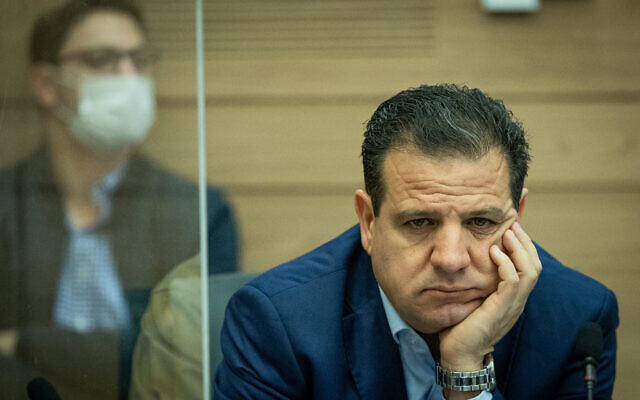
Joint List party chairman MK Ayman Odeh attends an Internal Security Committee meeting at the Knesset, in Jerusalem, on December 13, 2021. (Yonatan Sindel/Flash90)
Approximately 17% of Israel’s nearly 6.8 million eligible voters are Arab, according to data from the Central Bureau of Statistics and the Central Elections Committee. Historically, Israel’s Arab community — including Muslims, Christians, and Druze — has had lower turnout rates than Jewish voters.
In the past election, Arab turnout dropped to an all-time low of only 44%, compared to 72% among Jewish voters and 67% overall. The low turnout meant decreased representation among Arab parties in the Knesset. In 2020, when the four Arab parties ran together on the Joint List, Arab representation reached a record 15 seats. In 2021, after Ra’am pulled out of the Joint List, only 10 collective seats were won between them.
Now that the Joint List has further broken down into Hadash-Ta’al and Balad, with Ra’am continuing to run a separate campaign, Arab turnout has polled as low as 37% and as high as 48% in recent weeks.
Were either Hadash-Ta’al and Ra’am to fail to get back into the Knesset, the Likud-led bloc would be expected to proportionally benefit and have a path paved to power. If both fell short, Netanyahu’s prospects would be better still.
With both in Knesset, an opportunity would open up for Lapid to block another government from being formed. Likud asserts he might even pursue a coalition including or leaning on Hadash-Ta’al. Both Lapid and Hadash-Ta’al have refuted this as being a potential scenario.
In the final days of the campaign, some analysts have suggested Arab participation may prove higher than the polls have suggested, with even Balad potentially getting closer to clearing the 3.25% Knesset threshold. Previous elections have indicated that the pollsters have particular troubling predicting the Arab vote.
2. Haredi voter turnout
Renewed concern over Haredi voter turnout has cropped up in recent weeks, as voters allied with Ashkenazi Haredi party, United Torah Judaism, have become frustrated with the party’s management, after a year in the opposition.
UTJ currently has seven seats and has consistently polled to return this number. Low voter turnout or losing votes to another right-wing party may drop this number to six, a scenario that has caused much panic in Haredi political circles. However, only if the seat leaves the bloc would it affect the immediate stalemate.
Haredi voters represent 11% of the electorate, according to the Central Bureau of Statistics, and the bulk of their votes go to UTJ and Mizrahi Haredi party Shas. In the last election, Haredi voter turnout reached 80%.
However, the Kan public broadcaster reported that by mid-October, Haredi voter turnout was projected to drop by 12%.
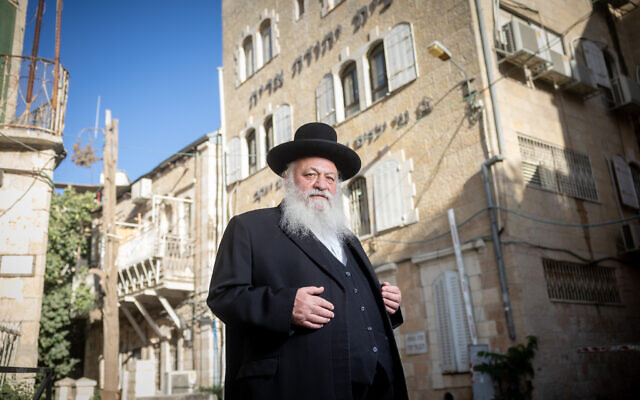
United Torah Judaism chairman Rabbi Yitzchak Goldknopf poses for a picture in Jerusalem on September 13, 2022. (Yonatan Sindel/Flash90)
A surge in popularity for Otzma Yehudit leader Itamar Ben Gvir, especially among younger or more nationalist Haredi voters, has also drawn votes away from the party, according to the polls.
About 6% of Haredi votes may be siphoned off to Religious Zionism-Otzma Yehudit, according to Kan. This would not change the bloc math or the ability to form a government, but it would shift power dynamics within that government if Haredi parties ultimately do lose seats.
3. Former Yamina voters searching for a home
Former ruling party Yamina won seven seats under Naftali Bennett in 2021, unexpectedly vaulting him to the premiership, but did not even make it onto the ballot this November. The party’s dissolution has created some political refugees.
Nearly a third of Yamina’s March 2021 voters identify as national religious, and are generally among the moderate, mainstream version of the diverse national religious spectrum. It also drew some of its base from some secular right-wing and traditional voters.
By contrast, 61% of the Religious Zionism party’s 2021 voters were national religious, and the party is considered to represent the hard-right end of that spectrum.

Ayelet Shaked (center) and Yossi Brodny (R) at a Jewish Home campaign event in Givat Shmuel on September 20, 2022. (Flash90)
Yamina’s legacy is now best represented by Jewish Home and its leader, Bennett’s former deputy Ayelet Shaked. But the party has consistently struggled in polls, and achieved only 1.5%-2% in the final major network polls at the weekend.
While many former Yamina voters have migrated to Religious Zionism or another party in the right or center, a portion is still considering voting for Shaked.
Shaked says that Netanyahu needs her to complete the numbers for his government; Netanyahu’s camp claims that she endangers the whole enterprise by burning right-wing votes on her way out of Knesset.
If voters sense that hope is lost and abandon her, they may shrink the number of wasted right-wing votes and pump Netanyahu up into striking distance of a majority. If, on the other extreme, Shaked outperforms expectations to make it into Knesset, she might hand Netanyahu additional seats — or preserve them for him, in the event that she pulls them from Likud in the first place.
4. Leftist parties nipping at the threshold
Poor performances from two more parties in Lapid’s bloc could tip the election Netanyahu’s way. Left-wing Meretz and center-left Labor are teetering near the threshold. Without much movement between blocs, much of Yesh Atid’s gradual rise in the polls over the months of the campaign has come at the cost of cannibalizing its partners to the left. Meretz and Labor have engaged in frantic last-minute efforts to convince voters to come out and cast their vote for them, rather than expand the number of seats Lapid’s Yesh Atid hopes to receive.
If either Labor or Meretz drops out of Knesset, polls predict a handy Netanyahu victory.
Labor leader Merav Michaeli summarily rejected Lapid’s efforts to unite her party and Meretz before the September candidate list deadline, preferring to preserve Labor as an independent outfit over what she perceived as providing a lifeline to Meretz.
Will that decision come back to haunt her?
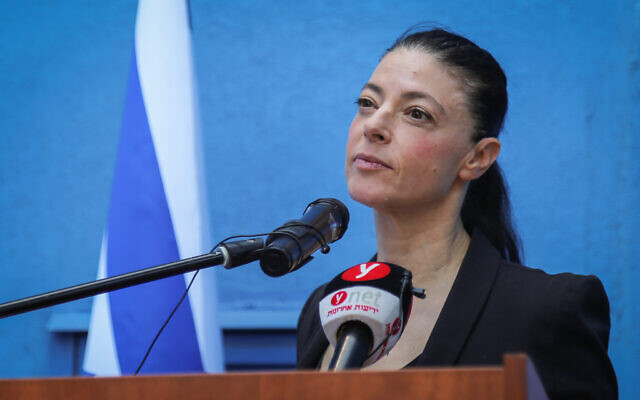
Transportation Minister Merav Michaeli holds a press conference, in Tel Aviv, September 14, 2022. (Flash90)
5. And yes, the weather
Perhaps the most banal of factors, expected inclement weather may put a damper on the willingness of unmotivated voters to head out to the polls. So much so that pundits expect that this could decrease turnout in some areas.
Israelis must vote in person at the specific polling station assigned to them, barring special circumstances including COVID-19-related quarantine, disability, or hospitalization.
On the other hand, rain across Israel also reduces the attractiveness of going to the beach, hiking, or making family picnics — all activities that historically compete with voting duties, as most Israelis enjoy a day off from work.
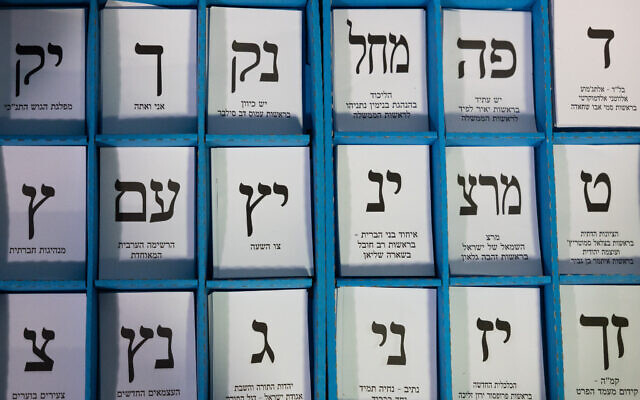
Workers prepare ballot boxes for the upcoming Israeli elections at the central elections committee warehouse in Shoham before they are shipped to polling stations, October 12, 2022. (Yonatan Sindel/Flash90)
World - Latest - Google News
November 01, 2022 at 11:15AM
https://ift.tt/GVcs1JF
As Israel votes for fifth time since 2019, these 5 factors could break the deadlock - The Times of Israel
World - Latest - Google News
https://ift.tt/mAhTUpK
Bagikan Berita Ini














0 Response to "As Israel votes for fifth time since 2019, these 5 factors could break the deadlock - The Times of Israel"
Post a Comment